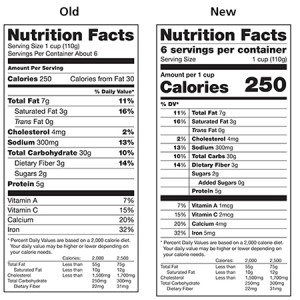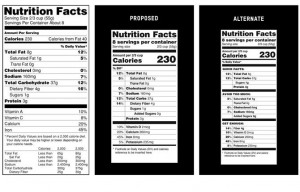How often do you use the Nutrition Facts label before making a food choice? The purpose of the label is to help consumers make healthier choices. You may choose one cereal over another because it contains more fiber, or a soup because it contains less sodium. Though the current label can help you do this, some of the information provided is not easily understood and may even be misleading.
The Nutrition Facts panel was first created for food packaging in 1994, following the passage of the Nutrition Labeling and Education Act of 1990. Since that time, the decision to include trans fat content has been the only noteworthy improvement, until now. On February 27th, the FDA and First Lady, Michelle Obama, proposed the first major update to the Nutrition Facts label, in 20 years.
Here are some highlights:
- The number of calories and the number of servings per container will be listed in bigger and bolder type. This information will be made more prominent, making it easier to find.
- Serving sizes will be adjusted to more accurately depict what consumers eat in one sitting. For example, a 20 oz. soda will be considered 1 serving, eliminating the need for consumers to multiply the number of calories and other nutrients by 2.5 servings, which has been the case in the past. Larger packages may now have two columns of nutritional information, one representing a serving, and the other representing the entire package.
- Calories from fat will no longer be listed. This allows consumers to focus on types of fat to be avoided, such as trans fat, rather than fat as a whole. Grams of total fat, saturated fat, and trans fat will still be listed.
- Added sugars will now be listed. This is a great addition; one that health advocates have been wanting for a long time. The Dietary Guidelines for Americans recommend that we consume less added sugars, but the current food label doesn’t indicate the number of sugars added to foods, only the total grams. This makes determining how much sugar manufacturers have added to products very challenging for consumers, especially for foods that contain natural sugars like fruit and dairy products.
- Vitamin D and potassium information will be listed. In addition, listing Vitamin A and C will now be voluntary. This change reflects the nutrients that most Americans aren’t getting enough of.
- Recommended Daily Values will change for sodium and fiber. Sodium will go down from 2400 mg to 2300 mg, and will go up for fiber from 25 g to 30 g. These numbers better represent how much we should consume of each of these nutrients based on a 2,000 kcal/day diet.
In addition to these important changes, the FDA has also proposed an alternate label that has received much less media attention.
The alternate label includes all of the changes mentioned above, but also provides information about which nutrients to avoid (trans fat, sodium, added sugars) and which to get more of (vitamin D, fiber, calcium).
What do you think? Would either of the proposed labels help you to make healthier choices?
For 90 days, the FDA will accept public comment on the proposed changes. Once the new standards are finalized and published, food manufacturers will have 2 years to comply. To read more about the issue and leave a comment, check out the links below:
LEAVE A COMMENT WITH THE FDA by June 2, 2014 at 11:59 PM ET
Read the FDA’s summary of the proposed changes
Read about the evidence supporting these changes
See all public comments submitted so far
Written By:
Bridgette Kidd, MPH, RD
Program Specialist, Healthy People
Ohio State University Extension, Family and Consumer Sciences
kidd.149@osu.edu
Reviewed by:
Melissa Welker, M.Ed.
Family and Consumer Sciences Extension Educator
Ohio State University Extension, Fulton County, Maumee Valley EERA
welker.87@osu.edu
Sources:
Food Labeling: Revision of the Nutrition and Supplement Facts Labels. Available at: https://www.federalregister.gov/articles/2014/03/03/2014-04387/food-labeling-revision-of-the-nutrition-and-supplement-facts-labels#p-128




It’s an important article. Congratulations I wish you continued success.